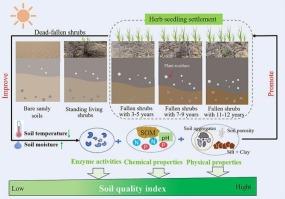Dead-fallen shrubs improve soil quality and promote herb seedling settlement in an arid sandy land of northern China
IF 6.6
1区 农林科学
Q1 SOIL SCIENCE
引用次数: 0
Abstract
Shrubs planted to combat desertification in China’s arid sandy lands often succumb to water deficits, yet the effects of dead-fallen shrubs on soil quality and herb establishment remain unclear. This study investigated soil properties and herb seedling settlement across bare sandy land (BSD), standing living shrubs (SLS), and dead-fallen shrubs at three decay stages (3–5, 7–9, and 11–12 years) in China’s Mu Us Sandy Land. Soil temperature, moisture, enzyme activities, physicochemical properties, and herb parameters (height, density, coverage, biomass) were analyzed and overall soil quality index (SQI) was calculated. Results revealed that dead-fallen shrubs significantly reduced soil temperature, increased soil water storage, improved soil physicochemical properties, eventually leading to a higher SQI under dead-fallen shrubs and a lower SQI under BSD and SLS in 0–5 cm soil. The herb seedling settlement parameters under dead-fallen shrubs were also higher than both under BSD and SLS. Regression analysis indicated that seedlings height, density, coverage and biomass were positively correlated with SQI, both in 0–5 cm and 5–10 cm soil. Structural equation modeling revealed that herb seedling settlement at 0–5 cm was driven by physicochemical properties, while at 5–10 cm soil depth relied on physical properties. Soil temperature exerted a direct negative influence on herb seedling establishment in both soil depths. This study highlighted that dead-fallen shrubs, particularly at advanced decay stages, outperform living shrubs in enhancing soil quality and facilitating herb establishment by modulating microhabitats and nutrient cycling, offering novel insights for sustainable restoration in arid ecosystems.

中国北方干旱沙地枯死灌木改善土壤质量,促进草本植物幼苗沉降
在中国干旱的沙地上,为防治荒漠化而种植的灌木经常因缺水而死亡,但枯死灌木对土壤质量和草本植物的影响尚不清楚。以毛乌素沙地为研究对象,研究了3 ~ 5年、7 ~ 9年和11 ~ 12年三个腐烂阶段,裸地、直立灌木和枯死灌木的土壤性质和草本植物幼苗沉降。分析了土壤温度、湿度、酶活性、理化性质和草本植物参数(高度、密度、盖度、生物量),计算了土壤综合质量指数(SQI)。结果表明:在0 ~ 5 cm土壤中,枯死灌木显著降低了土壤温度,增加了土壤储水量,改善了土壤理化性质,最终导致枯死灌木处理下SQI较高,BSD和SLS处理下SQI较低;枯死灌木下草本植物幼苗沉降参数也高于BSD和SLS。回归分析表明,在0-5 cm和5-10 cm土壤中,幼苗高度、密度、盖度和生物量与SQI呈显著正相关。结构方程模型分析表明,0 ~ 5 cm的土壤沉降主要受理化性质驱动,5 ~ 10 cm的土壤沉降主要受物理性质驱动。土壤温度对两种土壤深度的草本植物育苗均有直接的负向影响。本研究强调,枯死灌木,特别是在腐烂后期,通过调节微生境和养分循环,在改善土壤质量和促进草本植物建立方面优于活灌木,为干旱生态系统的可持续恢复提供了新的见解。
本文章由计算机程序翻译,如有差异,请以英文原文为准。
求助全文
约1分钟内获得全文
求助全文
来源期刊

Geoderma
农林科学-土壤科学
CiteScore
11.80
自引率
6.60%
发文量
597
审稿时长
58 days
期刊介绍:
Geoderma - the global journal of soil science - welcomes authors, readers and soil research from all parts of the world, encourages worldwide soil studies, and embraces all aspects of soil science and its associated pedagogy. The journal particularly welcomes interdisciplinary work focusing on dynamic soil processes and functions across space and time.
 求助内容:
求助内容: 应助结果提醒方式:
应助结果提醒方式:


